Hudson River Almanac 1/19/19 - 1/25/19
The New York State Department of Environmental Conservation sent this bulletin on 02/01/2019 02:00 PM EST |
| DEC Delivers - Information to keep you connected and informed from the NYS Department of Environmental Conservation |
| Share or view as a web page || Update preferences or unsubscribe |
|
Compiled by Tom Lake, Hudson River Estuary Program Consulting NaturalistOverviewArctic air temperatures were featured this week, so much so, that with briefly warmer air and heavy rain, a wall of ice and meltwater careened downriver from points north in the watershed causing havoc to vessels moored at the head of tide. With the Hudson filing with ice floes, wintering bald eagles began to sprinkle themselves along a 100-mile reach of the river. Highlight of the Week1/20 – Hudson Valley: Our full moon tonight was also what astronomers call a “super blood moon.” This occurs when a total lunar eclipse happens as the moon is at its closest point to the Earth (Perigee). This phenomenon will not recur until 2036. [Why is the super blood moon red? As the light from the sun hits the Earth, most of it is directly blocked creating a shadow. However, some light is refracted through the Earth’s atmosphere and bent around to hit the moon’s surface. When light is passed through a glass prism it is split into a rainbow of colors depending on the angle it was bent. Light from the sun passing through our atmosphere does the same, so when the sun is high in the sky, we see blue, when it is lower (or the light is passing through at a shallower angle) we see the reds of sunset and sunrise. When the light is passing through to the moon during an eclipse, it is a similar shallow angle, so we see reds as well. Anna Ross, Astronomer, Royal Observatory Greenwich, London] Natural History Entries1/19 – Minerva, HRM 284: We had 18-inches of fresh snow in our yard after the big snowstorm – beautiful snow, dense but not heavy. All the area schools were closed due to treacherous road conditions from freezing rain. In the afternoon, the air temperatures rose into the 40s with rain, and the melting snow caused flooding in the river.
1/19 – Ulster County, HRM 102-78: We held the Ulster County segment of the annual New York State Ornithological Association’s January Waterfowl Count today. Six field parties found a total of 7,866 birds comprising 13 species of waterfowl. We exceeded our most recent ten-year average for this county-wide effort of 11.7 species and 5,759 individuals. In addition, we counted 40 bald eagles (19 adults and 21 immatures) during the course of the waterfowl count. Noteworthy records included three cackling geese, a raft of 75 canvasbacks on the river at Esopus Meadows, and a wood duck and a northern pintail on Stone Ridge Pond. Typical of this annual mid-winter survey, two pervasive species accounted for 92% of our total abundance: Canada goose (69%) and mallard (23%). 1/20 – Buchanan, HRM 42: We awoke to several inches of snow this morning and were greeted by eleven dark-eyed juncos flitting around under our feeders. We hadn’t seen these winter birds in quite a while. It was interesting that with the first real snowfall of the year, these “snow birds” made an appearance. It was so delightful to see them scurrying around and chasing one another on the crust of the snow as they devoured the seeds that had fallen under the feeders. 1/20 – Buchanan, HRM 42: We watched in awe at 11:41 PM as the earth’s shadow slowly blotted out the full moon, culminating in a gorgeous super blood moon. 1/20 – Croton-on-Hudson, HRM 34: Late this afternoon, as I exited the Croton Library, I noticed a large flock of vultures circling to the west toward the river. I thought the birds might be coming back to a night roost, so I continued to watch them. Over the space of ten minutes, I counted more than fifty vultures landing in a tall pine tree or other trees nearby. It was quite remarkable. Even more surprising, before long, another large flock of vultures circled towards the roost and then landed in the pines. I am quite sure that they were all black vultures.
1/21 – Newcomb, HRM 302: Overnight, the air temperature fell to -17 degrees Fahrenheit (F). 1/21 – Farmer’s Landing, HRM 67: It was still an hour before sunrise. At first light my pack thermometer read -3 degrees F. Coupled with a 30 mile-per-hour northwest wind, the wind-chill was in the neighborhood of -40 degrees F. I had to turn away from the wind to breathe. Despite having no exposed skin, the severe cold seeped into the folds of my woolen scarf, hat, gloves and jacket. Ice floes choked the river. As the tide turned to flood, ice out in the deep-water channel was still slowly drifting seaward. Along the shore, however, the ice was beginning to grind its way upriver. 1/22 – Ulster Park, HR 78: In the wake of the snowstorm, we nearly had a full complement of woodpeckers at our suet feeder (albeit, not all at the same time): Downy, hairy, red-bellied, yellow-bellied sapsucker, and northern flicker. Only the pileated woodpecker did not show (we have never had a red-headed woodpecker at our feeders). 1/22 – Town of Poughkeepsie: The adult pair at bald eagle nest NY372 weathered the storm. They have shown little change in their daily routine of delivering nesting material and perching side-by-side on a horizontal limb near their nest. 1/22 – New Hamburg, HRM 67.5: The river was covered with ice floes, bank-to-bank, and they were studded with bald eagles. This could be one of those winters where we can count 100+ eagles on the ice on Haverstraw Bay. At least once, 15 years ago, we counted 200 on the ice across a seven-mile reach from George's Island to Ossining. This morning, we counted seven, two adults and five immatures, in the white expanse from east-to-west across the river. Our thermometer read five degrees F, but with just a slight breeze, the wind-chill was a manageable 0 degrees F. 1/23 – New Baltimore, HRM 131.5: I had one “ratty-tail” male common grackle at my feeders this morning along with a few brown-headed cowbirds. I would guess the cowbirds were holdovers from the fall migration. The grackle did not look terribly happy foraging around for seeds in the snow. [Addendum: After a few days, the male common grackle was looking good and acting alert and spry, a big improvement since he first arrived. Rich Guthrie]
[Dianne Picciano’s winter resident great blue heron on Lake Meahagh brought back memories of February 1997: The Hudson Valley had a sudden freeze that winter with water temperatures dropping precipitously over a couple of days. Hundreds of land-locked gizzard shad in Lake Meahagh “went belly up” from what ichthyologists call “winter kill.” Gizzard shad, a nonnative species, are vulnerable to the rigors of a northern winter. Pete Nye and I were at Lake Meahagh at the time monitoring a growing assemblage of wintering bald eagles attracted by the bounty of gizzard shad. Unfortunately for the eagles, the fish feast was tantalizingly trapped beneath a two-inch layer of clear ice. What to do? A great blue heron had taken up residence that winter in a sumac thicket along the lake. We watched for more than an hour as the great blue heron, with its chisel-like bill, cracked through the ice, again and again, and pulled out gizzard shad. And each time a fish was on the ice, an eagle would swoop down and steal it. Oddly, we thought, the heron never learned the lesson, and simply kept on prospecting with little to show for it. Tom Lake] 1/23 – Yonkers, HRM 18: Once again, our Sarah Lawrence Center for the Urban River at Beczak education team braved a frigid river (38 degrees F) to see what was around in the shallows. As it was a week ago, our six hauls of the seine produced no river life. We still gathered data, even if most of it was null data. Our big surprise was that the river’s salinity had risen from 2.0 to 8.0 parts-per-thousand, an almost quantum leap in an estuary. Much of that rise was probably caused by the deep-freeze up river locking up the freshwater and allowing brackish to intrude farther upstream. We eagerly await our first fish of 2019. 1/23 – Manhattan, HRM 1: We checked our research sampling gear today in Hudson River Park at The River Project's sampling station on the lighthouse tender at Pier 25. We are still waiting for our first fish of 2019. However, our killifish traps caught a dozen shore shrimp (Palaemonetes sp.), about as many isopods, and a few mud crabs (Panopeidae) – river life nonetheless. 1/24 – Albany County: I spent a few hours over the last two days birding the roadside edges in the rural and agricultural areas of central Albany County. I was hoping to find some winter field birds (song birds). The snow plows had cleared back some grassy margins and with some rain, there was much more open ground. In Voorheesville, I found an immature white-crowned sparrow feeding with juncos on some exposed grass. Farther on, there was at least one Savannah sparrow foraging with a small group of song sparrows. In a field, later on, I flushed a small flock of snow buntings. Finally, I found a few horned larks on a manure strip in a field in the Town of Knox. 1/24 – Manhattan, HRM 5: Three years ago, on this date (2016), New York City received 31-inches of snow.
1/25 – Rensselaer County, HRM 138: From Schodack Town Park, I could see that the Moordener Kill was jammed with ice from the thaw and heavy rains, enough to drown the Blue Trail that was now frozen over in spots. 1/25 – Rensselaer County, HRM 136: From Schodack Island State Park, at Schodack Landing this afternoon, I watched two Coast Guard cutters heading full speed upriver. They were likely heading there to lasso the errant boats that had escaped from their moorings in Troy. The second Cost Guard vessel had some difficulty against the oncoming ice floes that pushed the cutter backwards several times allowing the crew to see the same scenery more than once on their journey today. *** Fish of the Week *** With winter here and much of the watershed’s ponds, creeks, lakes, and rivers iced-over, some of us are going through fish withdrawal. As a coping device, until fully open water returns in March, we will have a “Fish of the Week” feature.
As an apprentice in the school of Hudson River fishes, our mentors taught us that the largemouth bass was an introduced species into New York from the Great Lakes region. As good students, however, we were also taught to never pass up an opportunity to question the dogma of our lessons. Fort William Henry, on Lake George in Warren County, was a Colonial fortification that helped guard the Hudson and Mohawk valleys, then known as “the frontier,” during the French and Indian War. For those of us who are curious by old accounts of unfamiliar fish names, we find reading the journal of Caleb Rea, the regimental surgeon for the English garrison at Fort William Henry (1755-1757), intriguing. The surgeon wrote how he “enjoyed fishing on Lake George.” After one successful trip he noted that he had “... caught Oswego bass, perch, roach, trout, etc. … but ye bass is ye biggest and counted ye best.” The perch were likely yellow perch; roach may have been golden shiners; and trout could have been either brook trout or lake trout. All of these fish are native to Lake George and our watershed. The “Oswego” bass” was the odd fish. Oswego bass have long been a regionally colloquial name for largemouth bass and conventional thinking has been that they were introduced into New York State from the Midwest in the middle of the 19th century. Therefore, they could not have been Caleb’s “ye biggest and counted ye best.” But, with the help of ichthyologist Bob Schmidt and DEC fisheries manager Scott Wells, we investigated the local origin of largemouth bass and discovered in the 1896 Annual Report of the New York Fisheries, Game and Forest Commission this statement: “Lake George is believed to be the natural habitat of black bass [largemouth bass], and the fish probably found its way at an early period from the St. Lawrence through Lake Champlain into Lake George.” Apparently, they were there in 1755. This gives us yet another story to tell our students about the lives and legends of New York State fishes. (Photo of largemouth bass courtesy of NJDEPA) [While very close to the border of the Hudson River watershed, Lake George is in the Saint Lawrence River watershed. Tom Lake] Winter 2019 Natural History ProgramsTBA Hudson River MilesThe Hudson is measured north from Hudson River Mile 0 at the Battery at the southern tip of Manhattan. The George Washington Bridge is at HRM 12, the Tappan Zee 28, Bear Mountain 47, Beacon-Newburgh 62, Mid-Hudson 75, Kingston-Rhinecliff 95, Rip Van Winkle 114, and the Federal Dam at Troy, the head of tidewater, at 153. The tidal section of the Hudson constitutes a bit less than half the total distance – 315 miles – from Lake Tear of the Clouds to the Battery. Entries from points east and west in the watershed reference the corresponding river mile on the mainstem. To Contribute Your Observations or to SubscribeThe Hudson River Almanac is compiled and edited by Tom Lake and emailed weekly by DEC's Hudson River Estuary Program. Share your observations by e-mailing them to trlake7@aol.com.
|

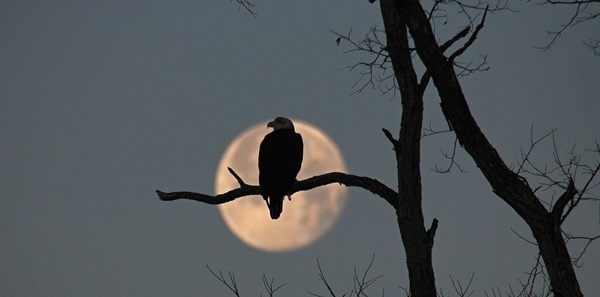 Hudson River Almanac
Hudson River Almanac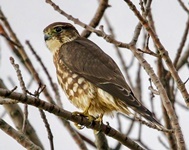 1/19 – Greene County, HRM 134-113: We conducted the annual NYSDEC waterfowl-eagle count along the Greene County side of the Hudson River from Coeymans Landing in southern Albany County to the south end of Catskill by the Ulster County line. The net of our survey was not exciting. We found many Canada Geese (our best guess was 2,090 birds), some common mergansers (51), a surprising number of mute swans (10), and not much more. We also had a belted kingfisher fly up from an open stream in Catskill. The highlight was watching a merlin take off from a treetop perch in Saugerties and snag a house sparrow right out of the air. (Photo of merlin courtesy of Deborah Tracy-Kral)
1/19 – Greene County, HRM 134-113: We conducted the annual NYSDEC waterfowl-eagle count along the Greene County side of the Hudson River from Coeymans Landing in southern Albany County to the south end of Catskill by the Ulster County line. The net of our survey was not exciting. We found many Canada Geese (our best guess was 2,090 birds), some common mergansers (51), a surprising number of mute swans (10), and not much more. We also had a belted kingfisher fly up from an open stream in Catskill. The highlight was watching a merlin take off from a treetop perch in Saugerties and snag a house sparrow right out of the air. (Photo of merlin courtesy of Deborah Tracy-Kral)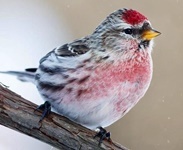 1/20 – New York Harbor, Upper Bay: Having read the cackling geese reports from Van Cortlandt Park in the Bronx, I went out to Randall’s Island this afternoon between the storm and the deep freeze to see what may have blown in. I spotted a small whitish finch flitting around the edge of the northwestern-most ball field. I considered that it might be a possible snow bunting. However, a better look revealed a common redpoll. That may have been a first of the species for Randall’s Island. (Photo of common redpoll courtesy of Cornell Lab of Ornithology)
1/20 – New York Harbor, Upper Bay: Having read the cackling geese reports from Van Cortlandt Park in the Bronx, I went out to Randall’s Island this afternoon between the storm and the deep freeze to see what may have blown in. I spotted a small whitish finch flitting around the edge of the northwestern-most ball field. I considered that it might be a possible snow bunting. However, a better look revealed a common redpoll. That may have been a first of the species for Randall’s Island. (Photo of common redpoll courtesy of Cornell Lab of Ornithology)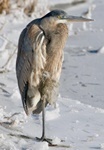 1/23 – Verplanck, HRM 40.5: While driving past Lake Meahagh this morning, I saw a large bird out on the ice. At first, I thought it was a bald eagle. But, a closer look made it out to be a great blue heron, and it was skating across the ice searching for open water. (Photo of great blue heron courtesy of Mia McPherson)
1/23 – Verplanck, HRM 40.5: While driving past Lake Meahagh this morning, I saw a large bird out on the ice. At first, I thought it was a bald eagle. But, a closer look made it out to be a great blue heron, and it was skating across the ice searching for open water. (Photo of great blue heron courtesy of Mia McPherson) 1/25 – Troy, HRM 152: A rapid upriver thaw sent a cascading wall of ice, snow, and meltwater down river that swept eight vessels from their moorings along the Hudson River at Troy this morning. Among the eight was a tugboat, the Betty D, that was carried over the seventeen-foot-high Federal dam at the head of tide. Another casualty was the Captain JP III, a four-deck cruise ship fitted to accommodate 600 passengers. The vessel was recovered in mid-morning when it became lodged against the Livingston Avenue Bridge, connecting Albany and Rensselaer counties, about seven miles downriver. (Photo of cruise ship Captain JP III courtesy of WNYT News Channel 13, Albany)
1/25 – Troy, HRM 152: A rapid upriver thaw sent a cascading wall of ice, snow, and meltwater down river that swept eight vessels from their moorings along the Hudson River at Troy this morning. Among the eight was a tugboat, the Betty D, that was carried over the seventeen-foot-high Federal dam at the head of tide. Another casualty was the Captain JP III, a four-deck cruise ship fitted to accommodate 600 passengers. The vessel was recovered in mid-morning when it became lodged against the Livingston Avenue Bridge, connecting Albany and Rensselaer counties, about seven miles downriver. (Photo of cruise ship Captain JP III courtesy of WNYT News Channel 13, Albany)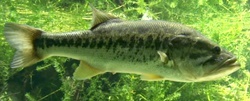 1/25 – Hudson Valley Estuary: This week’s fish is the largemouth bass (Micropterus salmoides), species number 155 (of 228) on our watershed list of fishes. Largemouth bass is a freshwater member of the sunfish family (Centrarchidae) and a very popular gamefish. The New York State angling record is 11 lb. 4 oz., a fish that was caught in Buckhorn Lake, Otsego County in 1987. If you would like a copy of our watershed fish list, e-mail:
1/25 – Hudson Valley Estuary: This week’s fish is the largemouth bass (Micropterus salmoides), species number 155 (of 228) on our watershed list of fishes. Largemouth bass is a freshwater member of the sunfish family (Centrarchidae) and a very popular gamefish. The New York State angling record is 11 lb. 4 oz., a fish that was caught in Buckhorn Lake, Otsego County in 1987. If you would like a copy of our watershed fish list, e-mail: